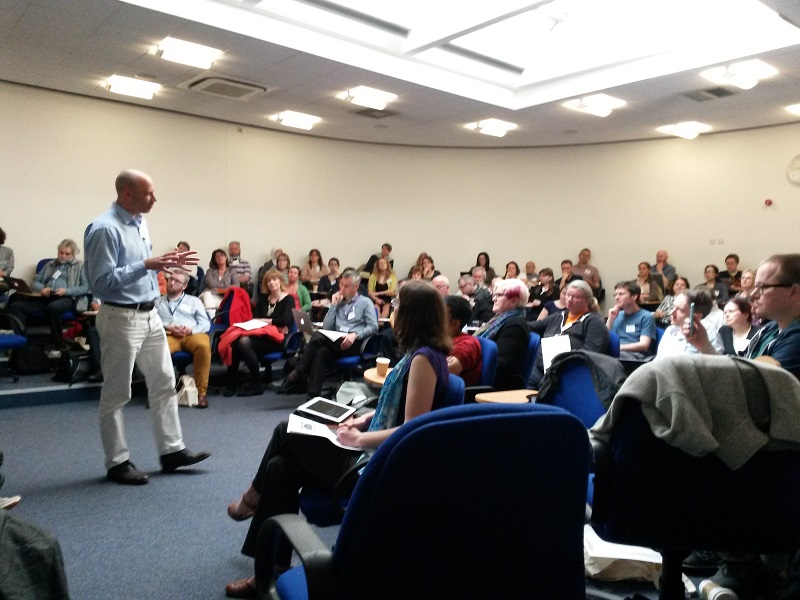eLearning@ed Conference 2015

Several colleagues from the Educational Design & Engagement team were able to attend the annual eLearning@Ed Conference on April 23rd, below is a summary of highlights from the day. The theme for this year’s conference was “Designing for 21st Century Learning.”
Mark Wetton
Attended “Co-Creation: Student Ownership of Curriculum” by EUSA’s Dash Sekhar, VPAA and Tanya Lubicz-Nawrocka
The student led co-creation breakout discussions. I had been reflecting on whether there is an opportunity to enshrine in policy the ‘right’ of our students to be able to contribute to their programme/course learning design at an appropriate level. This fits with the Learning and Teaching Vision reference to students as active agents, but also values their input and feed-forward into course refinement, review and improvement. It seems consistent with a ‘practice what we preach’ culture.
The students talked about growing good practice, but stubborn silo’s of reluctance to change. A policy might help unstick this stubbornness?
This may already be in development through the work Fiona is doing and through CSPC and PCIM initiatives, but may be a step further that communicates this to our students, and emphasises the benefit to students and their ‘Edinburgh Experience’. We should focus on the ‘why’ this is important element; a point that was emphasised by Prof Judy Hardy. We have some good examples of practice to involve students in both design and a basic level of digital literacy from areas such as Divinity. The co-creation and student inclusion theme also should articulate well with flexible and informed choice around pace, place and mode of learning and creating multiple opportunities for student refection and feedback, both to each other and their course organisers.
Ellen Spaeth:
“Using technology to support learner’s goal setting” by Professor Judy Robertson
When Judy Robertson, Professor of Digital Learning, stood up and announced that she would be speaking about using technology to support learners’ goal setting, my interest was piqued: I have a particular interest in goal setting, and wrote a number of blog posts on the subject during my PhD.
In particular, Judy focused on using technology for encouraging health behaviour change. Again, my ears pricked up: I’ve been doing the “Couch to 5k” programme, which encourages people to start running through a series of pre-set, carefully-sequenced goals, consisting of intervals of walking and running. There are a number of mobile apps that take you through each workout, telling you when to walk and when to run, tracking your distance, and even playing music. “Fantastic,” I thought, “technology for health behaviour change! This is for me.”
But Judy’s talk went far beyond that: Rather than looking at attaining pre-set goals, she was interested in how users set their own goals. The embodiment of this was Critter Jam (aka FitQuest), a game for children in the school playground. In Critter Jam, virtual goals, such as escaping a wolf or collecting coins, are reached via physical activity, such as running. Children can choose a goal: A personal best, a set amount of points, or topping the leaderboard.
Judy briefly presented data from a study looking at the goals children set in this type of game, whether they achieved them, the link between self-efficacy (confidence in one’s own abilities) and goal setting, and how children adjusted their goals based on success or failure. A striking contrast could be seen in reasons for setting relatively low targets: Some chose low targets after a failure so they could build up to their original goal, while others did so even after reaching much more challenging targets, to ensure their continued success. The fear of failure seen in the latter example seems to be actively impeding improvement, and it would be worth considering this in the context of Higher Education: If we do not give students space to be wrong, and learn from mistakes, then perhaps we too are actively impeding improvement.
Kelly Hall
“CMC Vellore India partnership – Online MSc in Family Medicine” by Liz Grant and Jo Spiller
Liz and Jo spoke about setting up the Online Distance Programme for the Masters in Family Medicine. One of the reasons this programme was set up is so that doctors in India would be able to study family medicine, which is not an option that is easily available. By offering this programme they aim to provide better care for patients within the community. This in turn will hopefully create a healthier community and healthier people. I very much enjoyed this presentation as it reminded me why I love working in the eLearning sector: This programme is changing communities for the better and it’s possible because of the dedication and hard work of many individuals, but it is also possible because of eLearning technology.





